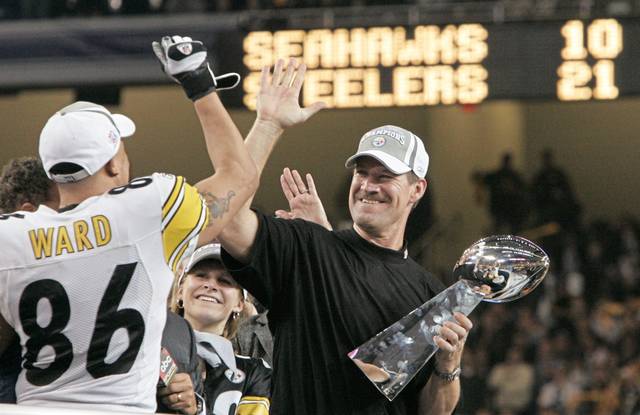Tim Benz: Steelers inductions part of needed debate for Hall of Fame changes
Share this post:
Many debates have popped up this week over who should — and shouldn’t — get into the Pro Football Hall of Fame as a result of the 2020 “Centennial Slate.”
I default to one self-reflective question: “What makes me more angry? Borderline guy who gets in? Or those who are kept out?”
It’s the second thing. By far.
In other words, there isn’t one part of me that thinks the Hall of Fame is a worse place because the likes of Jimbo Covert, Donnie Shell, Bill Cowher and Jimmy Johnson are in it.
Can you really talk about the ‘85 Bears without Covert? Or the “Steel Curtain” without Shell? Or the 15-year swath of time between 1990 and 2005 without teams coached by Johnson and Cowher?
No. You can’t. So I’m not put off by their inclusion.
However, it bothers me that guys such as Alan Faneca and Roger Craig may not get gold jackets. At least not any time soon.
That’s the issue moving forward.
The Hall of Fame appears to have wanted some free advertising for the actual, physical museum. And the league wanted some good ol’ fashioned, back-slapping public relations.
OK. No qualms here.
Just understand, with expanded inclusion, we are going to hear a lot more arguments that go like this:
“Well, if ‘Player A’ got inducted in the special 2020 class, then ‘Player B’ should get inducted in 2021.”
Or 2022. Or 2023.
For instance, former Eagles receiver Harold Carmichael has been selected. I’m not going to rail against that.
But Oakland Raiders great Cliff Branch and Dallas Cowboys legend Drew Pearson were not.
Carmichael’s regular-season numbers are better than those of Pearson and Branch. But his playoff numbers are dwarfed by those two peers at his position, as they played on the great Cowboys and Raiders teams of the 1970s and 1980s. So — in the same era as Carmichael — they were constantly in the playoffs and shined on a regular basis.
In 22 postseason games, Pearson had 68 catches for 1,131 yards and eight touchdowns. Branch had 73 catches, 1,289 yards and five scores in the same number of appearances. Carmichael played in only seven playoff games, catching 29 passes for 465 yards and six touchdowns.
None of that is to denigrate Carmichael. Rather, it is an effort to highlight that fans in Oakland and Dallas have a case when arguing on behalf of Branch and Pearson.
And therein lies the debate.
Maybe what we’ve learned here is that the process of voting is flawed, more so than the standards the voters are trying to enforce.
Apparently, the standards are flexible. For a year that ends in a zero, anyway.
So the process should’ve changed, too.
Via the Hall’s own website, here’s how it works.
“The Hall facilitates the procedure of three successive reviews of increasing scrutiny with its 48 selectors. The first is a vote to reduce the long list of Modern-Era nominees (typically around 100) to 25 semifinalists, followed by a later vote to reduce to 15 finalists. At the annual ‘Selection Saturday’ Meeting, the finalists are scrutinized even further by the Selectors, who after a thorough discussion of each nominee reduce the list from 15 to 10 and then 10 to 5. At that point, the five remaining nominees are voted on for membership on a yes or no basis. A minimum positive vote of 80 percent is necessary for election.”
In other words, worthy candidates get backlogged by the elimination stages. Guys who might get “yes” votes at an 80% rate don’t get in because they never get to that final level.
Since great players retire every year — and become eligible for consideration after five years — those potentially “80% worthy” players fall along the way in the weeding out process and finish somewhere between sixth and 15th annually.
Since the Hall changed up its rules anyway this year and opened the floodgates, here’s what it should’ve done.
The powers-that-be could have moved up the process on the calendar and staggered the ceremonies.
During the bye weekend between the championship games and the Super Bowl, they could’ve had a special induction weekend in Canton, Ohio for the 15 “Centennial Slate” nominees.
Then they should’ve expanded the regular list of Modern-Era entrants from five this year to any Modern-Era finalist who gets an 80% vote.
That’s how it should work anyway.
That way — especially if the museum is looking to boost visitation and publicity — they would have two induction weekends of potentially 30 men, instead of one weekend with 20.
This will thin the waiting list in 2021. It’ll also prevent 2020 bubble finalists such as Faneca, Tony Boselli and Steve Hutchinson from potentially becoming a threesome of offensive linemen of the same era waiting decades for induction like Pearson, Branch and Carmichael were a threesome of wide receivers doing the same thing.
If they ever get in at all.
Since the Hall of Fame is suddenly in the mood to rewrite standards of the past, maybe it should be more proactive about how to better apply procedure for the future.


